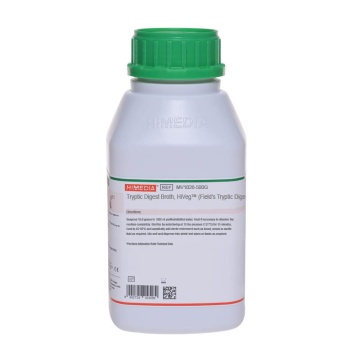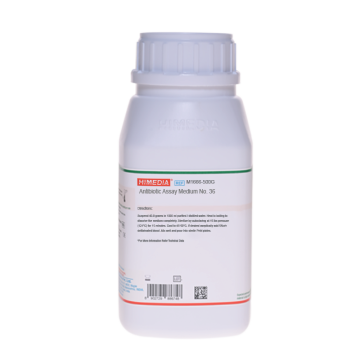 Your enquiry has been submitted
Your enquiry has been submitted
Field’s Tryptic Digest Broth (Tryptic Digest Broth)
Intended Use
Used for cultivation of fastidious microorganisms.
Composition**
| Ingredients | g/L |
|---|---|
| Tryptose B # | 10.000 |
| Sodium chloride | 5.000 |
| Dextrose (Glucose) | 1.000 |
| Final pH (at 25°C) | 7.6±0.2 |
**Formula adjusted, standardized to suit performance parameters
# Equivalent to Tryptic digest of beef heart
Directions
Suspend 16.0 grams in 1000 ml purified/distilled water. Heat if necessary to dissolve the medium completely. Sterilize by autoclaving at 15 lbs pressure (121°C) for 15 minutes. Cool to 45-50°C and aseptically add sterile enrichment such as blood, serum or ascitic fluid as required. Mix well and dispense into sterile test tubes or flasks or as desired.
Principle And Interpretation
Infusion based media are routinely employed for the cultivation of fastidious organisms. These media suffice complex nutritional requirements of most of the organisms. Field (1) formulated Tryptic Digest Broth for cultivation of fastidious microorganisms. Supplementation of the medium with serum, blood or ascitic fluid, it supports the growth of fastidious organisms such as, Neisseria meningitides, Haemophilus influenzae, Streptococcus pneumoniae etc. (2). Shepard et al (3) described its use for culturing Streptococcus pneumoniae and Actinomycetes.
Tryptose B provides carbonaceous and nitrogenous compounds and other essential growth nutrients for growth of fastidious microorganisms. Blood serum or ascitic fluid provides additional growth factors.
Type of specimen
Clinical samples - faeces, wounds etc.
Specimen Collection and Handling:
For clinical samples follow appropriate techniques for handling specimens as per established guidelines (4,5).
After use, contaminated materials must be sterilized by autoclaving before discarding.
Warning and Precautions :
In Vitro diagnostic Use only. For professional use only. Read the label before opening the container. Wear protective gloves/protective clothing/eye protection/ face protection. Follow good microbiological lab practices while handling specimens and culture. Standard precautions as per established guidelines should be followed while handling clinical specimens. Safety guidelines may be referred in individual safety data sheets.
Limitations :
- Individual organisms differ in their growth requirement and may show variable growth patterns on the medium.
- Each lot of the medium has been tested for the organisms specified on the COA. It is recommended to users to validate the medium for any specific microorganism other than mentioned in the COA based on the user's unique requirement.
- Further biochemical and serological tests must be carried out for further identification.
Performance and Evaluation
Performance of the medium is expected when used as per the direction on the label within the expiry period when stored at recommended temperature.
Quality Control
Appearance: Cream to light yellow homogeneous free flowing powder
Colour and Clarity of prepared medium
Basal Medium: Light yellow coloured clear solution. After addition of blood, cherry red coloured and with added serum or ascitic fluid, dark yellow coloured, opaque or clear to slightly opalescent solution respectively.
Reaction
Reaction of 1.6% w/v aqueous solution at 25°C. pH: 7.6±0.2
pH
7.40-7.80
Cultural Response
Cultural characteristics observed with added blood, serum or ascetic fluid after incubation at 35-37°C for 24 - 48 hours.
| Organism | Inoculum (CFU) | Growth |
|---|---|---|
| Bordetella pertussis ATCC 8467 | 50-100 | luxuriant |
| Haemophilus influenzae ATCC 35056 | 50-100 | luxuriant |
| Neisseria meningitidis ATCC 13090 | 50-100 | luxuriant |
| Staphylococcus aureus subsp. aureus ATCC 25923 (00034*) | 50-100 | luxuriant |
| Streptococcus pneumoniae ATCC 6303 | 50-100 | luxuriant |
| Streptococcus pyogenes ATCC 19615 | 50-100 | luxuriant |
Key: *Corresponding WDCM numbers.
Storage and Shelf Life
Store between 10-30°C in a tightly closed container and the prepared medium at 15-30°C. Use before expiry date on the label. On opening, product should be properly stored dry, after tightly capping the bottle in order to prevent lump formation due to the hygroscopic nature of the product. Improper storage of the product may lead to lump formation. Store in dry ventilated area protected from extremes of temperature and sources of ignition. Seal the container tightly after use. Product performance is best if used within stated expiry period.
Disposal
User must ensure safe disposal by autoclaving and/or incineration of used or unusable preparations of this product. Follow established laboratory procedures in disposing of infectious materials and material that comes into contact with clinical sample must be decontaminated and disposed of in accordance with current laboratory techniques (4,5).
Reference
- Field V. J., 1956, SAB Newsletter, 22:8.
- Atlas R. M., 2004, Handbook of Microbiological Media, Lawrence C. Parks (Ed.), 3rd Edition, CRC Press.
- Shepard M. C. and Lunceford C. D., 1976, J. Clin. Microbiol., 3:613.1
- Isenberg, H.D. Clinical Microbiology Procedures Handbook 2nd Edition.
- Jorgensen, J.H., Pfaller, M.A., Carroll, K.C., Funke, G., Landry, M.L., Richter, S.S and Warnock., D.W. (2015) Manual of Clinical Microbiology, 11th Edition. Vol. 1.
| Product Name | Field’s Tryptic Digest Broth (Tryptic Digest Broth) |
|---|---|
| SKU | M1028 |
| Product Type | Regular |
| Physical Form | Powder |
| Origin | Animal |
| Packaging type | HDPE |
| References | 1. Field V. J., 1956, SAB Newsletter, 22:8. |
| Customized Product Available | No |








